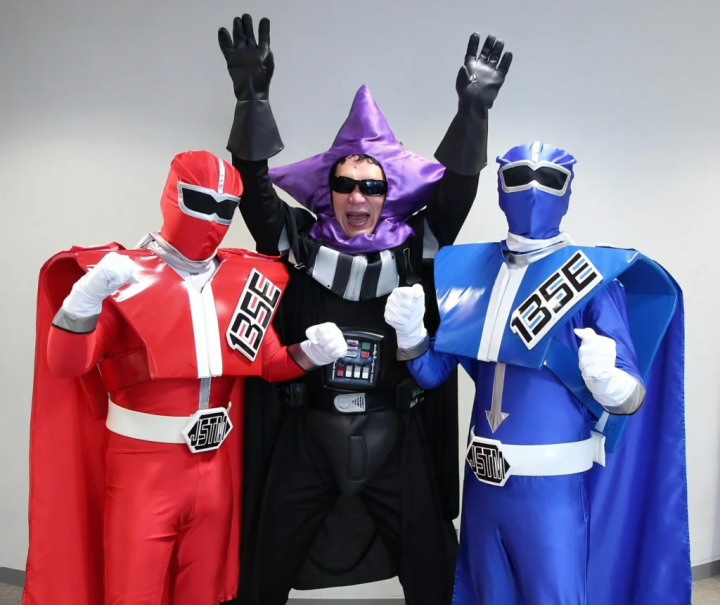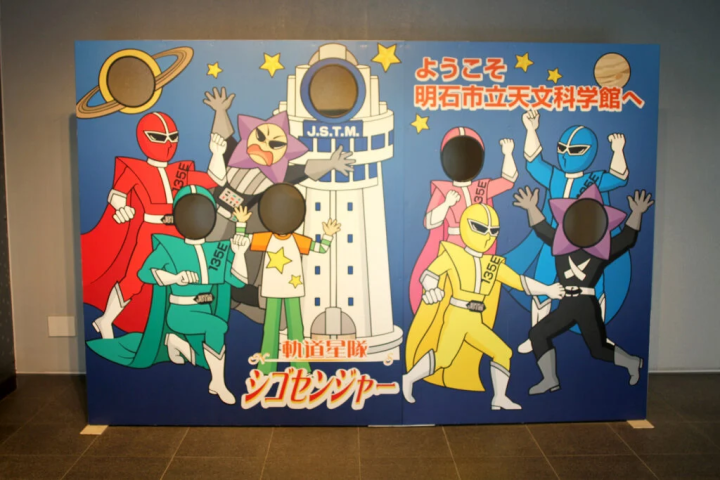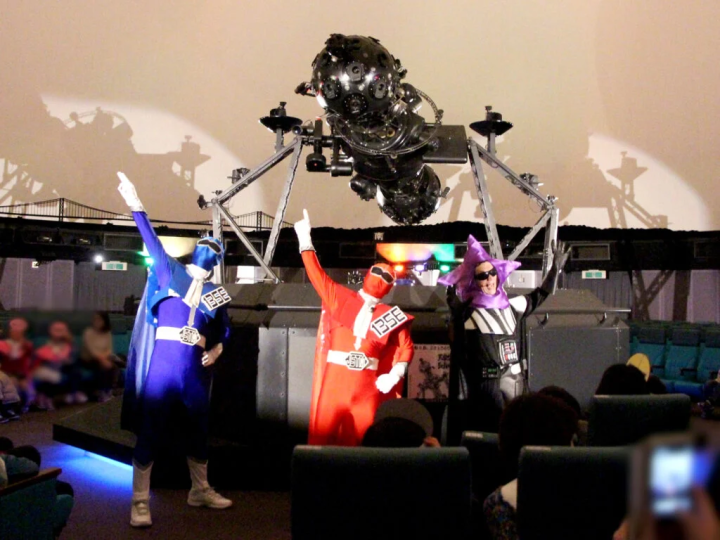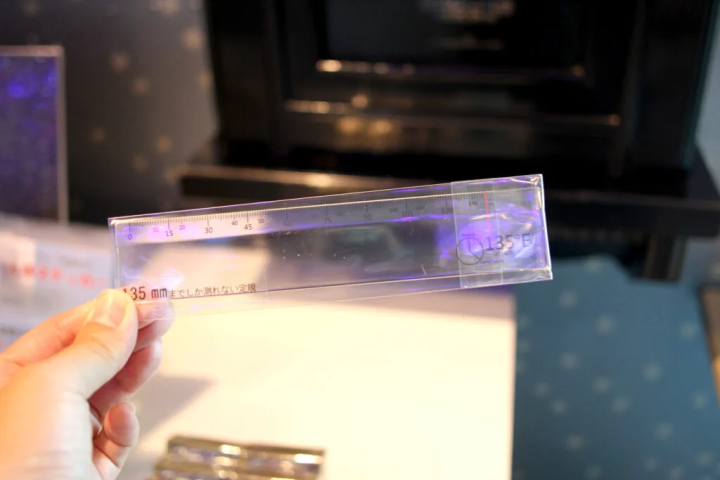[Akashi City] Japan's oldest operating planetarium! "Akashi City Astronomical Science Museum" with the theme of time and space
![[Akashi City] Japan's oldest operating planetarium! "Akashi City Astronomical Science Museum" with the theme of time and space](https://resources.matcha-jp.com/resize/720x2000/2023/12/09-156037.webp)
Inside the museum, there are exhibits where you can learn about time, astronomy, and space, as well as a planetarium dome with Japan's oldest operating planetarium. Additionally, the observation rooms on the 13th and 14th floors are popular viewing spots where you can see the entire Akashi Kaikyo Bridge.
-
Table of Contents
- A museum themed on “time and space”
- Japan's oldest planetarium in operation, established in 1960
- Popular with children! Orbital Star Corps Shigosenger
- Original goods sold at the museum shop
- basic information
A museum themed on “time and space”
![[Akashi City] Japan's oldest operating planetarium! "Akashi City Astronomical Science Museum" with the theme of time and space](https://resources.matcha-jp.com/resize/720x2000/2023/12/09-156038.webp)
The Astronomical Science Museum is located a 3-minute walk from Hitomaru-mae Station on the Sanyo Railway. It's about a 15-minute walk from JR Akashi Station, so we recommend stopping at Kame no Mizu, one of Harima's three famous waters, as you head there.
As you walk along, you will see the Astronomical Science Museum, a building with a large clock that can be clearly seen from a distance. The large clock is approximately 6.2 meters in diameter and is loved by the citizens as a symbol of the city of Akashi.

The Astronomical Science Museum opened on June 10, 1960. This museum has the theme of "time and space," and its unique feature is that it is located on the meridian of Japan Standard Time. The museum's opening day, June 10th, has been designated as the "Anniversary of Time," and events related to the anniversary are held every June.
![[Akashi City] Japan's oldest operating planetarium! "Akashi City Astronomical Science Museum" with the theme of time and space](https://resources.matcha-jp.com/resize/720x2000/2023/12/09-156040.webp)
The observation areas in the museum are the planetarium on the 2nd floor, the exhibition room on the 3rd floor, the sundial plaza on the 4th floor, the kids' room, the observation room on the 13th and 14th floors, and the astronomical observation room on the 16th floor. The exhibition room on the third floor has exhibits related to time, such as the meridian, clocks, and calendars, as well as exhibits on astronomy, space, and more.
![[Akashi City] Japan's oldest operating planetarium! "Akashi City Astronomical Science Museum" with the theme of time and space](https://resources.matcha-jp.com/resize/720x2000/2023/12/09-156041.webp)
The "Gallery of Time" in the third floor exhibition room is filled with models of clocks that measure time, including sundials, water clocks, quartz clocks, weight clocks, spring clocks, and pendulum clocks. You can learn about the mechanism of each clock, such as the movement of the hands.
![[Akashi City] Japan's oldest operating planetarium! "Akashi City Astronomical Science Museum" with the theme of time and space](https://resources.matcha-jp.com/resize/720x2000/2023/12/09-156042.webp)
The ``Astronomy Gallery'' on the same floor introduces information about astronomy, such as the sun, planets, meteorites, the galaxy, and space development, through exhibition panels and models.

Videos explaining topics such as ``From the Earth to the End of the Universe,'' ``Comparing the Sizes of Stars,'' and ``The Life of a Star'' are also shown on a large screen.

![[Akashi City] Japan's oldest operating planetarium! "Akashi City Astronomical Science Museum" with the theme of time and space](https://resources.matcha-jp.com/resize/720x2000/2023/12/09-156045.webp)
Four types of meteorites are also on display: iron meteorites, stony iron meteorites, stony meteorites echondrites, and stony meteorites chondrites.
Being able to touch a meteorite that actually fell to Earth is a very valuable experience! Let's take a closer look at the differences between each meteorite.
![[Akashi City] Japan's oldest operating planetarium! "Akashi City Astronomical Science Museum" with the theme of time and space](https://resources.matcha-jp.com/resize/720x2000/2023/12/09-156046.webp)
The sundial square on the 4th floor terrace has a variety of sundials on display, including the Gaia sundial, hemispherical sundial, and equatorial ring sundial. A sundial is said to be the first clock ever created by humans, and it uses sunlight to tell the time.
![[Akashi City] Japan's oldest operating planetarium! "Akashi City Astronomical Science Museum" with the theme of time and space](https://resources.matcha-jp.com/resize/720x2000/2023/12/09-156047.webp)
There's also an interesting sundial called the ``Human Sundial,'' which allows you to tell the time by standing on this month's footprint mark and checking the position of its shadow, so be sure to check it out.
![[Akashi City] Japan's oldest operating planetarium! "Akashi City Astronomical Science Museum" with the theme of time and space](https://resources.matcha-jp.com/resize/720x2000/2023/12/09-156048.webp)
There is also a kids' room with a nursing room on the 4th floor, making it safe for families with small children.

![[Akashi City] Japan's oldest operating planetarium! "Akashi City Astronomical Science Museum" with the theme of time and space](https://resources.matcha-jp.com/resize/720x2000/2023/12/09-156052.webp)
Take the elevator from the 4th floor to the 13th floor all at once.
The observation rooms on the 13th and 14th floors are popular viewing spots where you can see the cityscape of Akashi, Akashi Kaikyo Bridge, Awaji Island, and more. The view is very good as there is nothing blocking the view.

![[Akashi City] Japan's oldest operating planetarium! "Akashi City Astronomical Science Museum" with the theme of time and space](https://resources.matcha-jp.com/resize/720x2000/2023/12/09-156053.webp)
The ocean side is also popular among train enthusiasts, as you can clearly see JR and Sanyo Electric trains running. You can walk around 360° and enjoy the view of the mountain side.

Furthermore, there is an astronomical telescope with an aperture of 40 cm in the astronomical observation room on the 16th floor.
The dates for the public opening of the astronomical observatory are set, so if you are interested, please check the website in advance.
Japan's oldest planetarium in operation, established in 1960
![[Akashi City] Japan's oldest operating planetarium! "Akashi City Astronomical Science Museum" with the theme of time and space](https://resources.matcha-jp.com/resize/720x2000/2023/12/09-156054.webp)
The planetarium dome on the second floor is home to Japan's oldest operating planetarium.
![[Akashi City] Japan's oldest operating planetarium! "Akashi City Astronomical Science Museum" with the theme of time and space](https://resources.matcha-jp.com/resize/720x2000/2023/12/09-156055.webp)
The planetarium at the Astronomical Science Museum is a projector manufactured by Carl Zeiss Jena, a German company that was installed in 1960.In addition to approximately 9,000 fixed stars, the planetarium displays the sun, moon, five planets, the Milky Way, comets, variable stars, and artificial stars. Satellites etc. can be projected.

![[Akashi City] Japan's oldest operating planetarium! "Akashi City Astronomical Science Museum" with the theme of time and space](https://resources.matcha-jp.com/resize/720x2000/2023/12/09-156057.webp)
Apparently it survived the Great Hanshin-Awaji Earthquake in 1995, and is currently breaking records as Japan's oldest planetarium in operation. The projection program changes depending on the month, and we have a variety of programs for the general public, children, and babies.
Special programs are also held irregularly, such as the ``Star and Music Planetarium,'' where you can enjoy live music and the starry sky, and the ``Jokusuri Nettarium,'' where you can sleep in.
![[Akashi City] Japan's oldest operating planetarium! "Akashi City Astronomical Science Museum" with the theme of time and space](https://resources.matcha-jp.com/resize/720x2000/2023/12/09-156058.webp)
One of the highlights of the planetarium at the Astronomical Science Museum is that it is operated manually and that the staff provides live commentary. Even though the program is the same, each person's voice and commentary points are different, so we recommend watching the same program with different commentators.
![[Akashi City] Japan's oldest operating planetarium! "Akashi City Astronomical Science Museum" with the theme of time and space](https://resources.matcha-jp.com/resize/720x2000/2023/12/09-156059.webp)
Additionally, 2023 is the year of the 100th anniversary of the planetarium. From 2023 to 2025, commemorative events celebrating the 100th anniversary of planetariums will be held around the world, sponsored by the International Planetarium Association.
Planetarium-related events are also held at the Astronomical Science Museum, so be sure to check the website for the latest event information.
Popular with children! Orbital Star Corps Shigosenger

The ``Astronomical Science Museum'' has an original character called ``Orbital Star Corps Shigosenger'' who protects time and the universe.
The leaders, Shigosenger Red and Shigosenger Blue, are heroes who defeat the villain Dr. Black Star, who attempts to disrupt time and control the universe.


His specialty is "Shigosenger Quiz Attack". Shigosenger, who hates violence, fights off Dr. Black Star with an astronomical quiz. Shigosenger is very popular with small children as they can learn about astronomy while enjoying the show.
Be sure to check the website to find out when you can meet Shigosenger.
Reference: Shigosenger's appearance schedule
Original goods sold at the museum shop
![[Akashi City] Japan's oldest operating planetarium! "Akashi City Astronomical Science Museum" with the theme of time and space](https://resources.matcha-jp.com/resize/720x2000/2023/12/09-156063.webp)
After enjoying the museum to its fullest, be sure to stop by the museum shop on the first floor. There are also original goods that can only be purchased at the Astronomical Science Museum, so we recommend them as souvenirs to commemorate your visit.
![[Akashi City] Japan's oldest operating planetarium! "Akashi City Astronomical Science Museum" with the theme of time and space](https://resources.matcha-jp.com/resize/720x2000/2023/12/09-156064.webp)
These playing cards are original goods created to commemorate the 100th anniversary of the planetarium. The ``Playing Cards'' (1,350 yen) are designed with Japanese planetariums, and each card includes a photo of the planetarium and an explanation.


Akashi City Astronomical Science Museum, located on the meridian of Japan Standard Time at 135 degrees east longitude, is a facility where you can enjoy learning about time and space. While many planetariums are operated using digital devices, the planetarium programs are still operated by staff and live commentary is provided each time, making it a must-see.
If you are going out with your children, we recommend going on the days when Shigosenger appears. It's also a good idea to visit on days when events are held, such as the ``Daytime Solar Observation''.
(Writer Nakata/West Plan)
*This article is information as of June 2023. Prices include tax. Product contents and prices may change.
basic information
Akashi City Astronomical Science Museum
Address: 2-6 Hitomarucho, Akashi City, Hyogo Prefecture
Phone number: 078-919-5000
Business hours: 9:30-17:00 (Admission until 16:30)
Closed: Mondays, second Tuesday of each month (open on holidays, closed the next day), year-end
*Temporary openings and closings may occur.
Admission fee: All planetarium, exhibition room, observation room usage fee: 700 yen for adults, free for high school students and younger
* Only cash accepted
*Except for some projections, the planetarium requires numbered tickets on the day of each session.
Access: ・About 3 minutes walk from Sanyo Railway Hitomaru-mae Station ・About 15 minutes walk from JR Akashi Station
Parking: Available (90 spaces)
SNS: X
What are good things and good experiences? There are many characteristics such as having a story to tell, overflowing with the thoughts of the creator, having a history, and being loved by the locals. Have you ever come across a special thing or experience that made you want to tell someone about it? And as a result of telling, someone new leads to something. We think that's what "good" is all about. In order to deliver such encounters to our customers, we discover Hyogo's good things based on the concept of "talk, communicate, and connect", and provide information that will shorten the emotional distance between customers and the region of Hyogo Prefecture.
The contents on this page may partially contain automatic translation.
































![[2026 Edition] FORMUAL 1 JAPANESE GRAND PRIX Information](https://resources.matcha-jp.com/resize/720x2000/2025/10/05-245984.webp)


![[2025 Update] Namba's spectacular illuminations! "Namba Hikari Tabi" with approximately 1 million shining lights](https://resources.matcha-jp.com/resize/720x2000/2025/12/12-252825.webp)